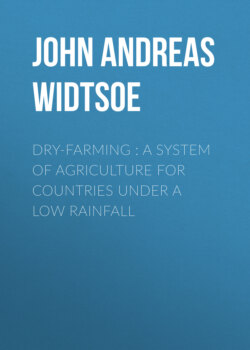Читать книгу Dry-Farming : A System of Agriculture for Countries under a Low Rainfall - John Andreas Widtsoe - Страница 11
На сайте Литреса книга снята с продажи.
DRY-FARM AREAS—RAINFALL
ОглавлениеThe annual precipitation of rain and snow determines primarily the location of dry-farm areas. As the rainfall varies, the methods of dry-farming must be varied accordingly. Rainfall, alone, does not, however, furnish a complete index of the crop-producing possibilities of a country.
The distribution of the rainfall, the amount of snow, the water-holding power of the soil, and the various moisture-dissipating causes, such as winds, high temperature, abundant sunshine, and low humidity frequently combine to offset the benefits of a large annual precipitation. Nevertheless, no one climatic feature represents, on the average, so correctly dry-farming possibilities as does the annual rainfall. Experience has already demonstrated that wherever the annual precipitation is above 15 inches, there is no need of crop failures, if the soils are suitable and the methods of dry-farming are correctly employed. With an annual precipitation of 10 to 15 inches, there need be very few failures, if proper cultural precautions are taken. With our present methods, the areas that receive less than 10 inches of atmospheric precipitation per year are not safe for dry-farm purposes. What the future will show in the reclamation of these deserts, without irrigation, is yet conjectural.
Arid, semiarid, and sub-humid
Before proceeding to an examination of the areas in the United States subject to the methods of dry-farming it may be well to define somewhat more clearly the terms ordinarily used in the description of the great territory involved in the discussion.
The states lying west of the 100th meridian are loosely spoken of as arid, semiarid, or sub-humid states. For commercial purposes no state wants to be classed as arid and to suffer under the handicap of advertised aridity. The annual rainfall of these states ranges from about 3 to over 30 inches.
In order to arrive at greater definiteness, it may be well to assign definite rainfall values to the ordinarily used descriptive terms of the region in question. It is proposed, therefore, that districts receiving less than 10 inches of atmospheric precipitation annually, be designated arid; those receiving between 10 and 20 inches, semiarid; those receiving between 20 and 30 inches, sub-humid, and those receiving over 30 inches, humid. It is admitted that even such a classification is arbitrary, since aridity does not alone depend upon the rainfall, and even under such a classification there is an unavoidable overlapping. However, no one factor so fully represents varying degrees of aridity as the annual precipitation, and there is a great need for concise definitions of the terms used in describing the parts of the country that come under dry-farming discussions. In this volume, the terms "arid," "semiarid," "sub-humid" and "humid" are used as above defined.
Precipitation over the dry-farm territory
Nearly one half of the United States receives 20 inches or less rainfall annually; and that when the strip receiving between 20 and 30 inches is added, the whole area directly subject to reclamation by irrigation or dry-farming is considerably more than one half (63 per cent) of the whole area of the United States.
Eighteen states are included in this area of low rainfall. The areas of these, as given by the Census of 1900, grouped according to the annual precipitation received, are shown below:—
Arid to Semi-arid Group
Total Area Land Surface (Sq. Miles)
Arizona 112,920
California 156,172
Colorado 103,645
Idaho 84,290
Nevada 109,740
Utah 82,190
Wyoming 97,545
TOTAL 746,532
Semiarid to Sub-Humid Group
Montana 145,310
Nebraska 76,840
New Mexico 112,460
North Dakota 70,195
Oregon 94,560
South Dakota 76,850
Washington 66,880
TOTAL 653,095
Sub-Humid to Humid Group
Kansas 81,700
Minnesota 79,205
Oklahoma 38,830
Texas 262,290
TOTAL 462,025
